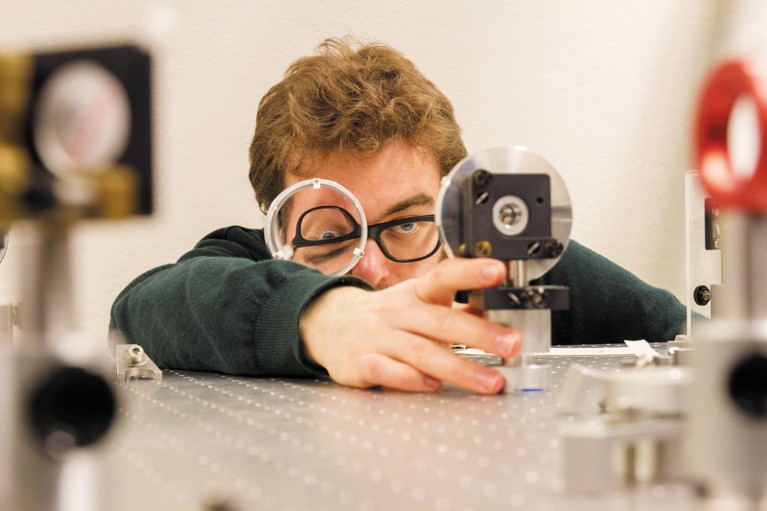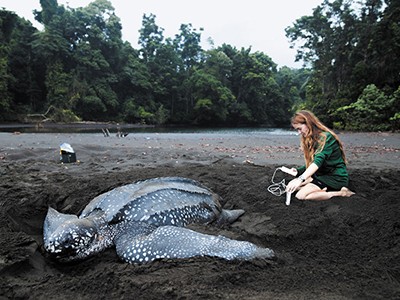
PhD student Joseph Beckwith was among more than 300 readers who sent images to Nature’s photo competition.Credit: Bogdan Dereka
If writing about music is like dancing about architecture, then writing about photography seems a tough ask indeed. Luckily, not everyone sees it that way — and certainly not when it comes to science. As the celebrated US photographer Berenice Abbott wrote in 1939: “To obtain wide popular support for science, to that end that we may explore this vast subject even further and bring as yet unexplored areas under control, there needs to be a friendly interpreter between science and the layman. I believe that photography can be this spokesman, as no other form of expression can be.”
In a Careers article this week, we celebrate both the spirit and the letter of Abbott’s words. During March, we asked readers to send in their own photographs to our 2018 #ScientistAtWork contest. Some 330 readers did so; entries ranged from images of researchers at work around the world to depictions of their actual work, and were assessed by a panel of Nature journalists and art editors.
The overall winner was a striking and beautifully framed shot of marine biologist Callie Veelenturf kneeling beside a leatherback sea turtle in Equatorial Guinea, taken by her colleague Jonah Reenders. The picture is worth a thousand words to us — or more — and a year’s personal subscription to Nature for Reenders and Veelenturf.
A photo celebration of scientists at work
Overall, the competition entries show the sheer diversity of modern research perhaps better than any words can. If teachers or scientists who visit schools want to demonstrate that the job of a scientist is varied and sometimes extraordinary, then this collection is a good start.
Photography and research have a history that started long before Abbott turned her lens to science. The technique started as a scientific endeavour — indeed, some artists rejected the medium because it looked too lifelike, in a way that a painting or an engraving never could. Still images have recorded, shared and prompted discovery ever since. From the very small, taken through microscopes, to the very far away, imaged by telescopes, photographs comprise an essential and valued contribution to the scientific record.
Can the camera lie? It can certainly bend scientific truth. James Nasmyth, the British engineer and amateur astronomer, produced what looked like impressive photographs of the Moon back in 1874. In fact, the photos were of detailed plaster models of the lunar surface that Nasmyth built from careful telescope observations. It took almost another century before genuine photos of the Moon emerged, under just as bizarre circumstances — when British astronomers used a giant radio telescope and a borrowed fax machine to hack into the 1966 signals sent from the Soviet space probe Luna 9.
Two more photos sent from space proved hugely influential. On Christmas Eve 1968, the Apollo 8 astronaut William Anders was stunned by what he saw from his window as they flew around the Moon: “Oh my God! Look at that picture over there! Here’s the Earth coming up. Wow, is that pretty … You got a color film, Jim?” The resulting image of our living planet suspended in space above the barren rocky surface of the Moon, called Earthrise, was described by the wildlife photographer Galen Rowell as “the most influential environmental photograph ever taken”.
More than two decades later, another picture of Earth — this time taken by the speeding Voyager 1 probe from 6 billion kilometres away — showed our planet as a mere speck of light amid vast surroundings and was named the Pale Blue Dot. (Technically, the picture is a composite made up of three separate frames, each taken through a different colour filter.)
Neutrons, viruses and the (former) planet Pluto: all were found thanks to photographs. But there is something else that runs through the images sent to Nature, and not something that is easily captured in academic prose. Spirit, perhaps, or joy; maybe what Abbott called “vivification of the visual image, the warm human quality of imagination added”. Do take a look and decide for yourselves.

 A photo celebration of scientists at work
A photo celebration of scientists at work
 Boosters, bacteria and human-sized drones — February’s top science images
Boosters, bacteria and human-sized drones — February’s top science images
 Gliders, glaciers and difficult goodbyes — March’s top science images
Gliders, glaciers and difficult goodbyes — March’s top science images



